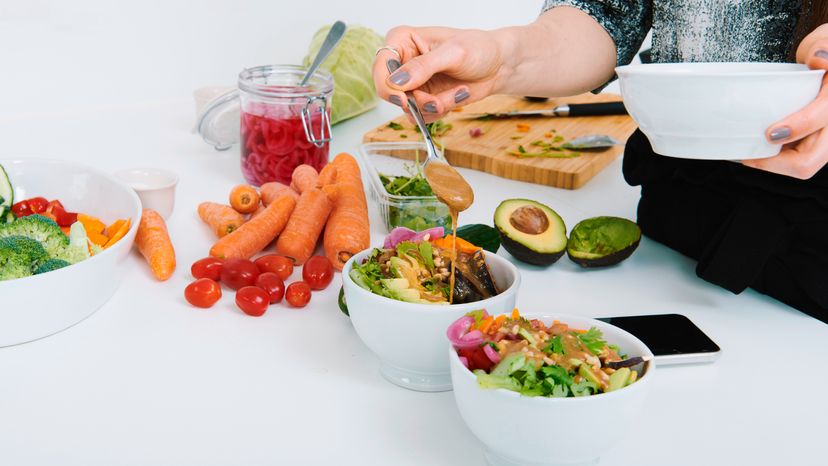
Although manufacturers introduce new flavors all the time, many consumers stick to their longtime favorites in salad dressings -- ranch, French, Italian, Caesar, blue cheese and Thousand Island -- and many of the dressings available in stores and restaurants are variations of these.
Most of the dressings you use either are creamy and have mayonnaise as a base ingredient or are oily and have salad oil as a base ingredient. The herbs, spices and other flavorings are added to make a certain kind of dressing.
Advertisement
Here are some of the favorites:
- Thousand Island dressing was named for the Thousand Island region of upstate New York, where the dressing originated. The region, along the St. Lawrence Seaway and Lake Ontario, is a popular spot for fishermen and hunters and for other tourists. The key ingredients in the dressing are mayonnaise and chili sauce, which is made of peppers and tomatoes. The tiny chunks in the dressing are finely chopped pickles, onions, olives and hard-cooked egg.
- Ranch dressing actually originated on a ranch -- the Hidden Valley Guest Ranch near Santa Barbara, Calif. According to the Hidden Valley Web site, the owners made a dressing with herbs, spices and buttermilk in the 1950s, and the dressing caught on with their guests. The dressing was sold as a dry mix that you combined with buttermilk and mayonnaise or sour cream. Now, the Hidden Valley brand appears on several varieties of bottled ranch dressing in supermarkets. It's also a very popular dip for vegetables or chips. The "ranch" flavor that is added to chips refers to the buttermilk taste that is associated with ranch dressing.
- French dressing is apparently an American invention. There are several different recipes for French dressing. Most of them use ketchup, oil, vinegar and paprika. A similar dressing is called Russian, which often has chili sauce as an ingredient.
- Italian dressing gets its name from the seasonings found in it -- oregano, basil and garlic mixed with olive oil and wine vinegar.
- Blue cheese dressing is sometimes referred to as Roquefort dressing, but Roquefort is a particular kind of blue cheese made of sheep's milk. It comes from the town of Roquefort in southwestern France. Regular blue cheese, a crumbly cheese that also has blue veins of mold, is made from cow's milk. The cheese is mixed with creamy ingredients such as mayonnaise, sour cream, buttermilk, milk or yogurt and often with vinegar and some spices.
- Caesar dressing comes from Caesar salad, a popular item on many restaurant menus. You will hear two different stories about the origin of the name for Caesar salad. One story is that it was named for Julius Caesar. Another story is that Caesar Cardini, an Italian immigrant to the United States, developed the salad dressing in the 1920s for his restaurant in Tijuana, Mexico. Caesar salad dressing is made of oil, lemon juice, raw egg, parmesan cheese, herbs and spices. Some recipes contain anchovy filets, too.
- Anchovy plays a role in the unique taste of another salad dressing with an interesting name, Green Goddess. Recipes for this dressing call for mayonnaise, anchovy fillets or paste, vinegar, garlic, green onion, parsley, chives and tarragon. The name apparently honored George Arliss, an early 20th century actor who was known mainly for his portrayal of Benjamin Disraeli, the British prime minister. Arliss appeared in a play titled "The Green Goddess," and a San Francisco chef named a new salad dressing after the play.
- Vinaigrette is a generic name for a salad dressing that uses oil and vinegar as its base and adds herbs and spices. There are many variations of vinaigrette, and it is popular because it can be lower in calories and fat than dressings that use mayonnaise.
If you read the labels on dressings in the grocery store, you will find that they almost always have a high fat gram count, unless they are "low fat" or "fat free." If it is important to you to watch your fat intake, then you will look for low-fat or fat-free varieties. But remember that if you are counting calories, the low-fat and fat-free flavors will probably have the same calorie count as high-fat flavors. And if you want to reduce your calorie intake by eating fresh vegetables in a salad, you need to watch the calorie count in the dressing, too!
Here are some interesting links:
- How Dieting Works
- How Calories Work
- How Fat Cells Work
- Hidden Valley Ranch Dressing
- The origin of Thousand Island dressing
- Caesar salad origin
- Salad recipes
- Searchable Online Archive of Recipes -- if you want to make your own dressings!
- The Association for Dressings and Sauces
Advertisement